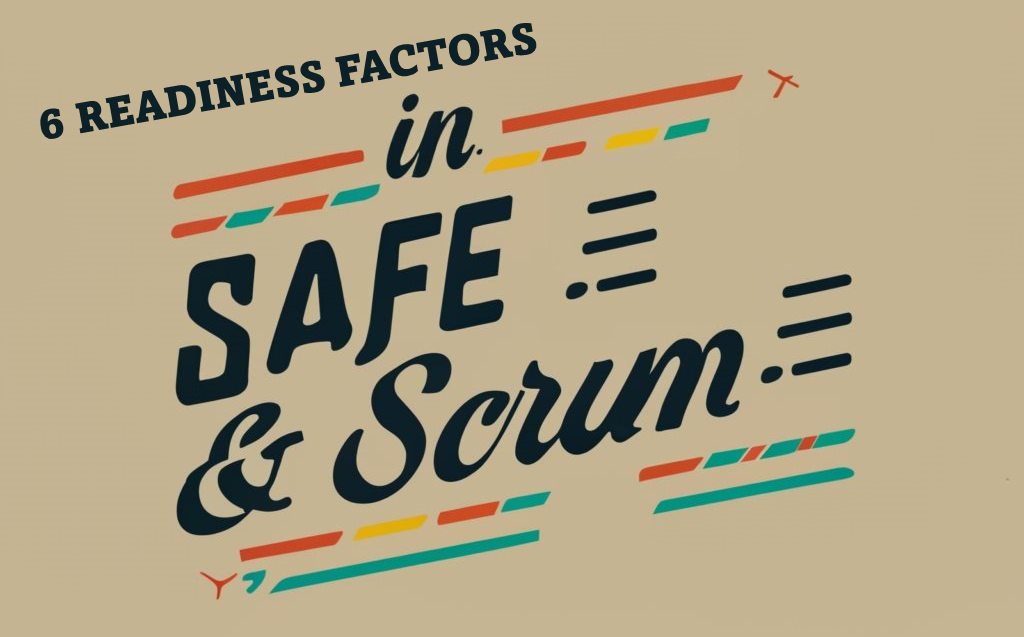Organizations worldwide face an era of exponential change as new technologies, competitors, and customer expectations emerge faster than ever. To thrive in these turbulent times, companies need frameworks and tools that help them quickly adapt and deliver value.

Many have turned to agile approaches like the Scaled Agile Framework (SAFe) or Scrum for their ability to promote fast feedback and incremental delivery. However, even these frameworks don’t explicitly address preparing for and navigating accelerated change.
That’s where the 6 Enterprise Agility Readiness Factors can help. These factors provide guidance on cultivating an agile, adaptive mindset across all levels of an organization. Incorporating them into SAFe or Scrum strengthens readiness for uncertainty and empowers people to embrace change as an opportunity. The 6 factors are:
- Industry Dynamics - Continuously evaluate your sector for emerging trends, innovations, and shifts that may impact your business. Don’t rely on past assumptions about the market.
- Company Culture - Foster a culture of experimentation, learning, and psychological safety. Make it safe for people to take risks, be vulnerable, and share ideas without fear of failure.
- Organizational Structures - Use flexible, cross-functional teams and networks instead of rigid hierarchies. Emphasize transparency, decentralization, and shared leadership.
- Market Sensing Capabilities - Develop systems and skills for detecting subtle market signals. Pay attention to early data points that may indicate future disruption.
- Customer Expectations - Maintain an outside-in perspective. Continuously gather insights into emerging customer needs, problems, and desires.
- Leadership Commitment - Leaders must model the agile mindset themselves. They should commit to learning, empowering teams, and guiding change.
These factors can be incorporated into SAFe practices like Team Charters, Program Backlogs, and Release Train planning. For example, add “Review Industry Dynamics” as a recurring activity in Team Charters. Or include “Sense Market SIgnals” in Program Backlogs. Leadership can demonstrate commitment by allowing time for sensing activities and experimentation.
Similarly, Scrum events like Retrospectives or Backlog Refinement are opportunities to assess readiness factors. Make discussions on adapting to change a regular Retrospective theme. Add readiness-building items like “Research on New Customer Expectations” to Backlogs. Here is a more in-depth look at incorporating the 6 Enterprise Agility Readiness Factors into SAFe and Scrum:
For SAFe:
- At the Team Level, add specific readiness-building activities to Team Charters. For example, have a recurring task like "Sense Market Signals" or "Experiment with New Technologies to sense the markets." Discuss readiness during team meetings.
- At the Program Level, build readiness into Program Backlogs and Program Increment (PI) Planning. Add items like "Research on New Customer Needs" or "Evaluate Market Signals." Have teams devote time during PI Planning to assessing readiness factors.
- At the Value Stream Level, discuss readiness during ART Sync meetings. Make it a regular agenda item to review factors like Industry Dynamics and Customer Expectations. Capture insights into Release Train backlogs.
- At the Portfolio Level, build readiness discussions into portfolio governance. Review factors during strategy meetings and portfolio backlog refinement. Task teams with reporting on dynamics like emerging competitors. This is also a good opportunity to evaluate how committed and prepared leadership is to embrace highly changing situations.
- Update structures related to management to include readiness reminders. Add columns to the existing boards related to Customer Expectations, Market Sensing, Industry Sensing, etc.
For Scrum:
- During Backlog Refinement, add readiness-specific items. For example, "Research Industry Innovations, Trends or Week Signals" or "Interview New Customers with Different Expectations." Make readiness a prioritization factor.
- In Sprint Planning, include time for readiness discussions. Review industry changes that may impact priorities or ways of working.
- In Daily Standups, have team members report on relevant readiness factors like new market entrants or emerging customer needs.
- Make readiness a recurring Retrospective theme. Reflect on changes needed to adapt, improve sensing, or address new challenges (check out why being Always Rady is important).
- Task Product Owners with gathering continuous insights into Customer Expectations and Industry Dynamics, and help them understand how to sense signals and especially weak signals and trends.
- Encourage Scrum Masters to regularly assess readiness factors and coach teams on embracing change.
In both frameworks, the key is to build in time and space for focusing on readiness, not just sprint execution. This strengthens the adaptive capacity to respond to both incremental and exponential change. With the right mindset and practices, organizations can leverage SAFe or Scrum to navigate uncertainty and drive innovation. It is also worth checking out Future thinking in Enterprise SAgility to better understand how to prepare the organization for the unpredictability ahead.
By integrating readiness factors into existing scaled agile practices, organizations build the resilient, adaptive foundation needed to navigate uncertainty. They gain the agility to respond quickly when disruptive change inevitably emerges. With the right mindset and capabilities, exponential change is transformed from a threat into an opportunity.
